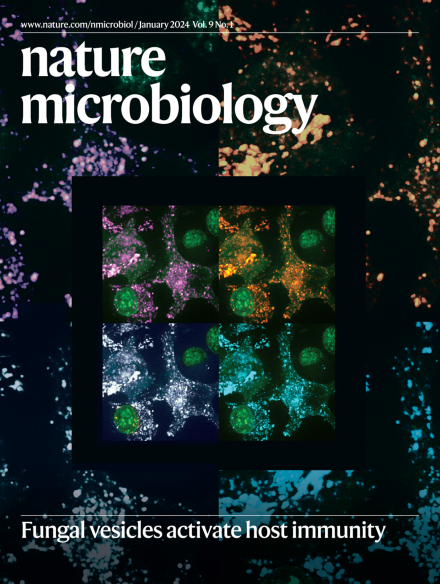Toxoplasma gondii VIP1 mediates parasitophorous vacuole-host endoplasmic reticulum interactions to facilitate parasite development.
IF 19.4
1区 生物学
Q1 MICROBIOLOGY
引用次数: 0
Abstract
Membrane contact sites (MCS) are areas of close apposition between organelles without membrane fusion, allowing for exchange of biomolecules. The endoplasmic reticulum (ER) forms many MCS via two proteins, vesicle-associated membrane protein-associated proteins A and B (VAPA and VAPB). The obligate intracellular parasite Toxoplasma gondii resides within mammalian cells in a parasitophorous vacuole (PV), which closely contacts the host ER at distances compatible with MCS. However, the proteins mediating this interaction remain largely unknown. Here, using molecular and microscopy approaches, we show that VAPA and VAPB localize at the PV membrane and, with motile sperm domain-containing protein 2 (MOSPD2), mediate ER-PV interactions. Cells deficient in VAPA, VAPB and MOSPD2 do not recruit host ER at the PV, and parasites show growth defects. We identify a parasite protein that localizes at the PV membrane, called TgVIP1, which harbours an FFAT-like motif that binds VAPA and VAPB. These findings lay the basis for understanding how and why Toxoplasma exploits ER-PV interactions and may uncover new drug targets.刚地弓形虫VIP1介导寄生物液泡-宿主内质网相互作用,促进寄生物发育。
膜接触点(MCS)是细胞器之间紧密接触的区域,没有膜融合,允许生物分子交换。内质网(ER)通过两种蛋白,囊泡相关膜蛋白相关蛋白A和B (VAPA和VAPB)形成许多MCS。专性细胞内寄生虫刚地弓形虫(Toxoplasma gondii)居住在哺乳动物细胞内的寄生液泡(PV)中,该液泡以与MCS兼容的距离密切接触宿主内质网。然而,介导这种相互作用的蛋白质在很大程度上仍然未知。在这里,我们使用分子和显微镜方法,我们发现VAPA和VAPB定位于PV膜,并与运动精子结构域含蛋白2 (MOSPD2)一起介导ER-PV相互作用。缺乏VAPA、VAPB和MOSPD2的细胞不能在PV处招募宿主ER,寄生虫表现出生长缺陷。我们发现了一种定位于PV膜的寄生虫蛋白TgVIP1,它含有一个类似ffat的基元,可以结合VAPA和VAPB。这些发现为理解弓形虫如何以及为什么利用ER-PV相互作用奠定了基础,并可能发现新的药物靶点。
本文章由计算机程序翻译,如有差异,请以英文原文为准。
求助全文
约1分钟内获得全文
求助全文
来源期刊

Nature Microbiology
Immunology and Microbiology-Microbiology
CiteScore
44.40
自引率
1.10%
发文量
226
期刊介绍:
Nature Microbiology aims to cover a comprehensive range of topics related to microorganisms. This includes:
Evolution: The journal is interested in exploring the evolutionary aspects of microorganisms. This may include research on their genetic diversity, adaptation, and speciation over time.
Physiology and cell biology: Nature Microbiology seeks to understand the functions and characteristics of microorganisms at the cellular and physiological levels. This may involve studying their metabolism, growth patterns, and cellular processes.
Interactions: The journal focuses on the interactions microorganisms have with each other, as well as their interactions with hosts or the environment. This encompasses investigations into microbial communities, symbiotic relationships, and microbial responses to different environments.
Societal significance: Nature Microbiology recognizes the societal impact of microorganisms and welcomes studies that explore their practical applications. This may include research on microbial diseases, biotechnology, or environmental remediation.
In summary, Nature Microbiology is interested in research related to the evolution, physiology and cell biology of microorganisms, their interactions, and their societal relevance.
 求助内容:
求助内容: 应助结果提醒方式:
应助结果提醒方式:


